 W
WA cabinet is a case or cupboard with shelves and/or drawers for storing or displaying items. Some cabinets are stand alone while others are built in to a wall or are attached to it like a medicine cabinet. Cabinets are typically made of wood, coated steel, or synthetic materials. Commercial grade cabinets usually have a melamine-particleboard substrate and are covered in a high pressure decorative laminate, commonly referred to as Wilsonart or Formica.
 W
WAdjustable shelving allows more flexible use of shelves to hold items of value for storage, display or sale. Like fixed shelves, the horizontal planes are normally made of strong materials such as wood or steel, but their exact vertical positioning can be varied - usually through the use of uprights into which supporting brackets or the shelves themselves can be fixed at different heights.
 W
WA bail handle, or simply bail, is a handle that consists of an open loop that moves freely within two fixed mounts or ears. Several designs are available: bails are typically made of metal (wire) or plastic. It is a type of package handle which may be used for carrying an item, such as a tin can or bucket; or kettle, or as a drawer pull. A bail handle can also be used to hang an item such as a pharmaceutical bottle potted plants, etc.
 W
WA baker's rack is a type of furniture with shelves, typically made of wrought iron or some other metal. "Since the 17th century, baker’s racks have been part of many homes around the world. This versatile storage furniture has gained its name because it has been originally used by bakers." The shelves are made of a conductive material, often steel or iron, which served to help cool a baker's goods such as hot pies, breads, and pastries. The conductivity and thermal mass of metal not only allows for heat to be quickly transferred from the pan to the shelf, but held for a long time. This allowed the cooling process to be equally distributed so baked goods maintained their integrity.
 W
WA bathroom cabinet is a cabinet in a bathroom, most often used to store hygiene products, toiletries, and sometimes also medications such that is works as an improvised medicine cabinet. Bathroom cabinets are usually placed under sinks, over sinks, or above toilets. Many mirror cabinets are combined with a lamp that illuminates the mirror and thereby also the room. Bathroom cabinets often either have an integrated electrical socket or are placed close to one so that appliances such as an electric shaver or hairdryer can be used. Bathroom cabinets have become much more technologically advanced with retailers today offering features like Bluetooth audio, mood lighting, and anti-fog technology.
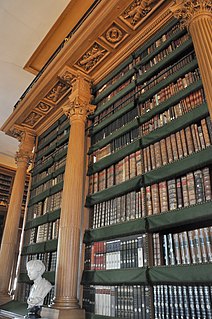 W
WA bookcase, or bookshelf, is a piece of furniture with horizontal shelves, often in a cabinet, used to store books or other printed materials. Bookcases are used in private homes, public and university libraries, offices and bookstores. Bookcases range from small, low models the height of a table to high models reaching up to ceiling height. Shelves may be fixed or adjustable to different positions in the case. In rooms entirely devoted to the storage of books, such as libraries, they may be permanently fixed to the walls and/or floor.
 W
WA closet is an enclosed space, with a door, used for storage, particularly that of clothes. Fitted closets are built into the walls of the house so that they take up no apparent space in the room. Closets are often built under stairs, thereby using awkward space that would otherwise go unused.
 W
WA cellarette or cellaret is a small furniture cabinet, available in various sizes, shapes, and designs which is used to store bottles of alcoholic beverages such as wine or whiskey. They usually come with some type of security such as a lock to protect the contents. Such wooden containers for alcoholic beverages appeared in Europe as early as the fifteenth century. They first appeared in America in the early eighteenth century and were popular through the nineteenth century. They were usually made of a decorative wood and sometimes had special designs so as to conceal them from the casual observer. They were found in pubs, taverns, and homes of the wealthy.
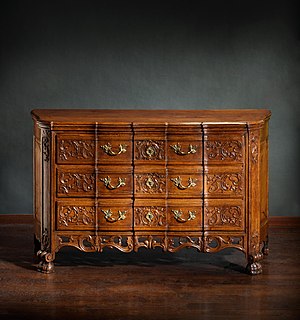 W
WA chest of drawers, also called a dresser or a bureau, is a type of cabinet that has multiple parallel, horizontal drawers generally stacked one above another.
 W
WA chiffonier, also chiffonnier, may be used to describe at least two types of furniture. Its name comes directly from a French piece of furniture, the chiffonier. The French name, which comes from the French for a rag-picker, suggests that it was originally intended as a receptacle for odds and ends which had no place elsewhere.
 W
WA chifforobe, also chiffarobe or chifferobe, is a closet-like piece of furniture that combines a long space for hanging clothes with a chest of drawers. Typically the wardrobe section runs down one side of the piece, while the drawers occupy the other side. It may have two enclosing doors or have the drawer fronts exposed and a separate door for the hanging space.
 W
WA china cabinet is a piece of furniture, usually with glass fronts and sides, used to hold and display porcelain ("china") or other ceramics. Typical china held in such cabinets often includes cups, plates, bowls, and glasses. Along with a table, chairs, and a sideboard, the china cabinet is one of the most typical elements of a traditional dining room in the Western world, though they may be placed in any room. Historically, they were used for especially highly-decorated cabinet cups, that were too expensive and perhaps fragile for regular use, and made for collectors or to be given as presents.
 W
WA closet is an enclosed space, with a door, used for storage, particularly that of clothes. Fitted closets are built into the walls of the house so that they take up no apparent space in the room. Closets are often built under stairs, thereby using awkward space that would otherwise go unused.
 W
WA commode is any of many pieces of furniture. The Oxford English Dictionary has multiple meanings of "commode". The first relevant definition reads: "A piece of furniture with drawers and shelves; in the bedroom, a sort of elaborate chest of drawers ; in the drawing room, a large kind of chiffonier." The drawing room is itself a term for a formal reception room, and a chiffonier is, in this sense, a small sideboard dating from the early 19th century.
 W
WA console television is a type of CRT television most popular in, but not exclusive to, the United States and Canada. Console CRT televisions are distinguished from standard CRT televisions by their factory-built, non-removable, wooden cabinets and speakers, which form an integral part of the television's design.
 W
WThe term cupboard was originally used to describe an open-shelved side table for displaying dishware, more specifically plates, cups and saucers. These open cupboards typically had between one and three display tiers, and at the time, a drawer or multiple drawers fitted to them. The word cupboard gradually came to mean furniture for enclosing dishware or grocery items that are stored in a home.
 W
WA curio cabinet is a specialised type of display case, made predominantly of glass with a metal or wood framework, for presenting collections of curios, like figurines or other interesting objects that invoke curiosity, and perhaps share a common theme. A curio cabinet may also be used to display a solitary object of special interest, such as a hand-crafted doll.
 W
WA display case is a cabinet with one or often more transparent tempered glass surfaces, used to display objects for viewing. A display case may appear in an exhibition, museum, retail store, restaurant, or house. Often, labels are included with the displayed objects, providing information such as description or prices. In a museum, the displayed cultural artifacts are normally part of the museum's collection, or are part of a temporary exhibition. In retail or a restaurant, the items are normally being offered for sale. A trophy case is used to display sports trophies or other awards.
 W
WA drawer DROR is a box-shaped container inside a piece of furniture that can be pulled out horizontally to access its contents. Drawers are built into numerous types of furniture, including cabinets, chests of drawers (bureaus), desks, and the like.
 W
WA drawer pull is a handle to pull a drawer out of a chest of drawers, cabinet or other furniture piece.
 W
WA false bottom is an internal partition in a container, typically at the bottom of a drawer, suitcase or similar item, enabling the concealment of objects from a cursory examination of the item's contents. A false bottom may be present if the internal dimensions of a container do not match its external dimensions after taking into account the thicknesses of constituent materials and structures used to build the object.
 W
WA filing cabinet is a piece of office furniture for storing paper documents in file folders. In the most simple context, it is an enclosure for drawers in which items are stored. The two most common forms of filing cabinets are vertical files and lateral files. A vertical file cabinet has drawers that extend from the short side of the cabinet. A lateral file cabinet has drawers that extend from the long side of the cabinet. These are also called side filers in Great Britain. There are also shelf files, which go on shelves. In the United States, file cabinets are usually built to accommodate 8.5 × 11 paper, and in other countries, filing cabinets are often designed to hold other sizes of paper, such as A4 paper.
 W
WThe Furniture History Society (FHS), which was founded in 1964, is a registered charity in the United Kingdom
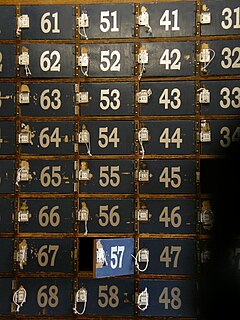 W
WA getabako (下駄箱) is a shoe cupboard in Japan, usually situated in the genkan, an entryway or porch of the house. This is often called a cubby in the United States. In Japan, it is considered uncouth to not remove one's shoes before entering the house. Near the getabako is a slipper rack, and most people in Japan wear slippers around the house, except for rooms which have tatami flooring, as they are bad for the floor. The getabako is usually made of wood and bamboo, and there are many sold all over the world.
 W
WA Hoosier cabinet is a type of cupboard or free-standing kitchen cabinet that also serves as a workstation. It was popular in the first few decades of the 20th century in the United States, since most houses did not have built-in kitchen cabinetry. The Hoosier Manufacturing Co. of New Castle, Indiana, was one of the earliest and largest manufacturers of this product, causing the term "Hoosier cabinet" to become a generic term for that type of furniture. By 1920, the Hoosier Manufacturing Company had sold two million cabinets.
 W
WJohn Evelyn's cabinet is a highly decorated storage box in the collection of the Victoria & Albert Museum in London. The cabinet was probably made in Florence for the diarist John Evelyn (1620-1706), and is an early example of a piece of furniture commissioned by a British visitor making the 'Grand Tour' of Europe.
 W
WKitchen cabinets are the built-in furniture installed in many kitchens for storage of food, cooking equipment, and often silverware and dishes for table service. Appliances such as refrigerators, dishwashers, and ovens are often integrated into kitchen cabinetry. There are many options for cabinets available at present.
 W
WA lazy Susan is a turntable placed on a table or countertop to aid in distributing food. Lazy Susans may be made from a variety of materials but are usually glass, wood, or plastic. They are circular and placed in the centre of a table to share dishes easily among diners. Although they are common in Chinese restaurants, the lazy Susan is a Western invention. Owing to the nature of Chinese cuisine, especially dim sum, they are common at formal Chinese restaurants both in mainland China and abroad. In Chinese, they are known as 餐桌转盘 or "dinner-table turntables".
 W
WTraditionally, a linen-press is a cabinet, usually of woods such as oak, walnut, or mahogany, and designed for storing sheets, table-napkins, clothing, and other textiles. Such linen-presses were made chiefly in the 17th, 18th, and 19th centuries and are now considered decorative examples of antique furniture. Early versions were often simple, with some exhibiting carving characteristic of Jacobean designs. Examples made during the 18th and 19th centuries often featured expensive veneers and intricate inlays, and were designed to occupy prominent places in early bedrooms as storage closets for clothing.
 W
WA locker is a small, usually narrow storage compartment. They are commonly found in dedicated cabinets, very often in large numbers, in various public places such as locker rooms, workplaces, middle and high schools, transport hubs and the like. They vary in size, purpose, construction, and security.
 W
WA lowboy is an American collectors term for one type of dressing table, vanity, or duchess. It is a small table with one or two rows of drawers, so called in contradistinction to the tallboy or highboy chest of drawers.
 W
WA medicine cabinet is a cabinet used to store medications and other hygiene products. They are often locked and placed high enough such that it can not be accessed by small children. Medicine cabinets can be placed in many different places like depending on the intended use and available space, and can for instance be found in workshops, bathrooms or hallways. Non-lockable bathroom cabinets are sometimes used as improvised medicine cabinets.
 W
WMobile shelving, mobile aisle shelving, compactus, roller racking, or rolling stack, are terms applied to shelving or storage units fitted with wheeled traction systems. Units can be closely packed when access is not required, but can be readily moved to open up an aisle to allow access. By eliminating the need for a permanently open aisle between every unit, a smaller proportion of floor space can be allocated to storage than in the case of conventional fixed shelving, or a higher capacity of storage can be met using the same footprint as fixed shelving.
 W
WModern Gothic exhibition cabinet is a piece of Modern Gothic furniture now in the collection of the Metropolitan Museum of Art. Although its design was once attributed to Philadelphia architect Frank Furness and furniture maker Daniel Pabst, MMA now credits its design and manufacture to Pabst alone. At 8 feet (2.4 m) tall, it is an unusually large and polychromatic American example of the rare style.
 W
WProfessional organizing emerged as an industry in 1984 within Los Angeles. A professional organizer assists individuals and businesses to improve their organizing systems and process.
 W
WRotary storage systems are specialised office filing units designed to offer increased storage volumes per square foot compared to traditional filing units.
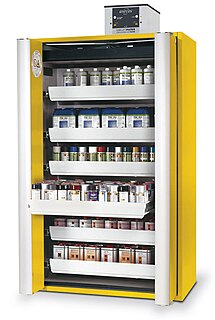 W
WA safety cabinet is used for the safe storage of flammable chemical substance or compressed gas cylinders.
 W
WA shelf is a flat, horizontal plane used for items that are displayed or stored in a home, business, store, or elsewhere. It is raised off the floor and often anchored to a wall, supported on its shorter length sides by brackets, or otherwise anchored to cabinetry by brackets, dowels, screws, or nails. It can also be held up by columns or pillars. A shelf is also known as a counter, ledge, mantel, or rack. Tables designed to be placed against a wall, possibly mounted, are known as console tables, and are similar to individual shelves.
 W
WStipo a bambocci is a writing cabinet, which was made during the Renaissance in Upper Italy and which can be locked by a fall-front.
 W
WA taboret or stool refers to two different pieces of furniture: a cabinet or a stool.
 W
WA tallboy is a piece of furniture incorporating a chest of drawers and a wardrobe on top. A highboy consists of double chest of drawers, with the lower section usually wider than the upper. A lowboy is a table-height set of drawers designed to hold a clothes chest, which had been the predominant place one stored clothes for many centuries.
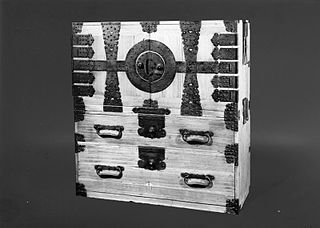 W
WTansu is the traditional mobile storage cabinetry indigenous to Japan. Tansu was first recorded in the Genroku era of the Edo period (1688–1704). The two characters, tan and su, appear to have initially represented objects with separate functions: the storage of food and the carrying of firewood. Since the radical for bamboo appears in each of these characters, it may be conjectured that wood was not as yet used.
 W
WA Tantalus is a small wooden cabinet containing two or three decanters. Its defining feature is that it has a lock and key. The aim of that is to stop unauthorised people drinking the contents, while still allowing them to be on show. The name is a reference to the unsatisfied temptations of the Greek mythological character Tantalus.
 W
WAn umbrella stand is a storage device for umbrellas and walking sticks. They are usually located inside the entrance of a home or public building, and are sometimes complemented by a hanger or mirror, or combined with a coat rack.